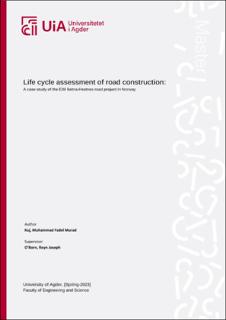| dc.description.abstract | This master thesis assesses the environmental impacts caused by constructing E39 Betna-Hestnes
Road Project in Trøndelag County, Norway, by using LCA methodology. additionally, this thesis seeks
to identify potential measures that can be implemented to mitigate the project's environmental
impacts.
Norway has made a commitment to reduce greenhouse gas emissions by 50% by the year 2030. This
thesis is important for Bertelsen and Garpestad who are actively working towards achieving more
environmentally friendly road construction. Furthermore, it also serves as a valuable resource for
organizations, administrations, and stakeholders involved in the road construction sector, as it
provides insights and strategies for effectively mitigating the impacts and emissions in their road
projects.
The construction phase of the entire E39 Betna-Hestnes project results in a total of 19,900 tons of
CO2 equivalent and had a total water consumption of approximately 118,500 m3. The total
terrestrial acidification resulting from constructing the E39 Betna-Hestnes road project is calculated
to be 85.2 tons of SO2 equivalent and terrestrial ecotoxicity is calculated to be 65654,3 ton1,4
dichlorobenzene. In general, the main contributors to these emissions are Concrete(B45),
reinforcement rebar steel, asphalt, and prefabricated beams.
1.2 million liters of fuel consumed by just construction machinery and mass transport is remarkably
high and huge. The material consumption activities have the biggest overall emissions related to
(GWP, water use, and terrestrial acidification & ecotoxicity). The fossil-free construction site and
machinery in E39 Betna-Hestnes will significantly mitigate carbon dioxide emissions during
construction.
It becomes apparent that the use of timber instead of concrete in bridges could have more favorable
environmental outcomes. This is primarily due to the quantities of cement and rebar steel required in
concrete bridge structures, which leads to higher raw-materials demand and higher energy demand
during the production phase from non-renewable sources. | |
